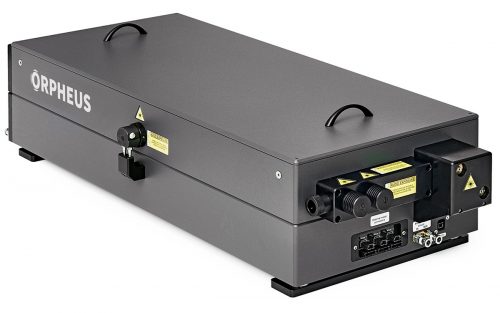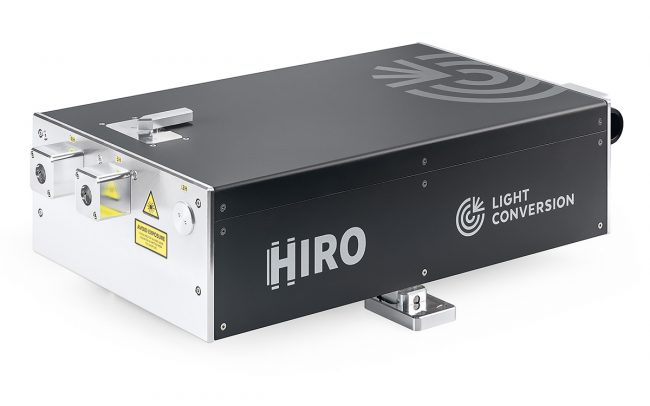Two-dimensional electronic spectroscopy (2DES) is an ultrafast laser spectroscopy technique that allows studying ultrafast phenomena in condensed-phase systems. The term electronic refers to the fact that the optical frequencies in the visible spectral range are used to excite the electronic energy states of the system.
This technique records the signal emitted from a system after an interaction with a sequence of three laser pulses. Such pulses usually have a time duration of a few hundred femtoseconds, provided by PHAROS or CARBIDE femtosecond lasers. This high time resolution allows capturing of dynamics inside the system that evolves with the same time scale. The main result of this application is a two-dimensional absorption spectrum that shows the correlation between excitation and detection frequencies.
According to Gelžinis et al., the key strengths of 2D spectroscopy are the following. First, the uncoupling of time and excitation frequency resolution allows the researchers to follow specific states’ dynamics with selective excitation and excellent time resolution. Second, the lack of background signals means that an excellent signal-to-noise ratio can be achieved. Third, a single run of 2D spectroscopy provides information with a wide range of excitation frequencies while using the pump-probe technique that requires many separate measurements. All things considered, for the last fifteen years, 2D spectroscopy has contributed heavily to our understanding of excitation dynamics in photosynthetic molecular complexes. It is a safe bet that it will continue to do so for the foreseeable future.
Two-dimensional spectroscopy may be also used in the IR spectral range, where vibrational states are investigated; see two-dimensional infrared spectroscopy (2DIR).
- 100 fs – 20 ps 连续可调脉宽
- 最大单脉冲能量 4 mJ
- 最小脉宽输出 < 100 fs
- POD 和 BiBurst 功能
- 高达 5 次谐波或可调谐扩展
- CEP 稳定或重复频率锁定
- 热稳定性和密封设计
- 190 fs – 20 ps 连续可调脉宽
- 最大输出 1 mJ @ 120 W 或 2 mJ @ 80 W
- 单脉冲 – 2 MHz 重复频率
- POD 和 BiBurst 功能
- 高达 5 次谐波或可调谐扩展
- 风冷型号
- 紧凑的工业级设计
- 结合共线和非共线 OPA 的最佳特性
- 650 – 900 nm & 1200 – 2500 nm 可调波长
- 单脉冲 – 2 MHz 重复频率
- 脉宽 < 100 fs
- 可调光谱带宽
- 波长调谐无间隙的长脉冲模式
Low energy excited state vibrations revealed in conjugated copolymer PCDTBT
S. Irgen‑Gioro, P. Roy, S. Padgaonkar, and E. Harel, The Journal of Chemical Physics 4 (152), 044201 (2020).
Both electronic and vibrational coherences are involved in primary electron transfer in bacterial reaction center
F. Ma, E. Romero, M. R. Jones, V. I. Novoderezhkin, and R. van Grondelle, Nature Communications 1 (10) (2019).
Potential pitfalls of the early-time dynamics in two-dimensional electronic spectroscopy
D. Paleček, P. Edlund, E. Gustavsson, S. Westenhoff, and D. Zigmantas, The Journal of Chemical Physics 2 (151), 024201 (2019).
Exciton–Phonon Spectroscopy of Quantum Dots Below the Single-Particle Homogeneous Line Width
A. P. Spencer, W. O. Hutson, S. Irgen‑Gioro, and E. Harel, The Journal of Physical Chemistry Letters 7 (9), 1503-1508 (2018).
Identification and characterization of diverse coherences in the Fenna–Matthews–Olson complex
E. Thyrhaug, R. Tempelaar, M. J. P. Alcocer, K. Žídek, D. Bína, J. Knoester, T. L. C. Jansen, and D. Zigmantas, Nature Chemistry 7 (10), 780-786 (2018).
Discrimination of Diverse Coherences Allows Identification of Electronic Transitions of a Molecular Nanoring
V. Butkus, J. Alster, E. Bašinskaitė, R. Augulis, P. Neuhaus, L. Valkunas, H. L. Anderson, D. Abramavicius, and D. Zigmantas, The Journal of Physical Chemistry Letters 10 (8), 2344-2349 (2017).
Quantum coherence selective 2D Raman–2D electronic spectroscopy
A. P. Spencer, W. O. Hutson, and E. Harel, Nature Communications 1 (8) (2017).
Dark States in the Light-Harvesting complex 2 Revealed by Two-dimensional Electronic Spectroscopy
M. Ferretti, R. Hendrikx, E. Romero, J. Southall, R. J. Cogdell, V. I. Novoderezhkin, G. D. Scholes, and R. van Grondelle, Scientific Reports 1 (6) (2016).
Mapping multidimensional electronic structure and ultrafast dynamics with single-element detection and compressive sensing
A. P. Spencer, B. Spokoyny, S. Ray, F. Sarvari, and E. Harel, Nature Communications 1 (7) (2016).
Real-time observation of multiexcitonic states in ultrafast singlet fission using coherent 2D electronic spectroscopy
A. A. Bakulin, S. E. Morgan, T. B. Kehoe, M. W. B. Wilson, A. W. Chin, D. Zigmantas, D. Egorova, and A. Rao, Nature Chemistry 1 (8), 16-23 (2015).




